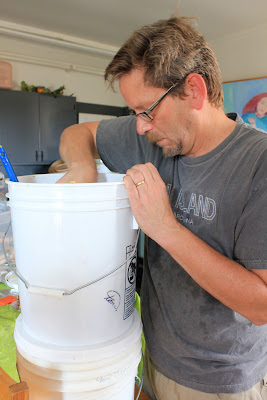
Tom, my wonderful bee-keeping mentor and neighbor, has really been earning his pay lately! After helping me harvest the Langstroth hives and the crazy top compartment of the Warre hives last week, he returned Friday to help me with the Warre supers and again on Sunday to share a few tips about using the extracting tools.
This is the view of the bottom of one of the Warre supers, the way they are supposed to be. The bees constructed uniform comb hanging neatly from the bars so each section could be easily removed.
A gratuitous photo of the bees on the comb, just because I love how they look. (Click to enlarge.)
Here is a closeup shot of a few bars of the Warre comb, filled with honey and capped with wax. In the Warre hives, the bees design their own comb architecture which hangs freely from a top bar. (In the Langstroth hives the comb is built within wooden frames, upon a base with a prescribed cell pattern.)
We packaged some of the beautiful Warre comb intact, as comb honey. But for most of it, we cut the combs off the bars and crushed them in a 5-gallon bucket with a metal strainer at the bottom. The honey slowly drained through the strainer, and then through a fine nylon mesh cloth into the bottom bucket to remove wax and any other contaminants.
We were using our summer kitchen as our honey house, and had heated the room to 100 F so that the honey would flow more easily and quickly. Whew!
As mentioned previously, the comb of the Langstroth hive is constructed in sturdy rectangular frames, so we didn't have to crush the comb to remove the honey. First, we removed the wax covering that seals the honey inside the cells. We used a hot knife to slice off the wax cap layer. We uncapped the frames over tubs to catch the wax and capture the dripping honey. Don't want to lose any of that precious golden honey!
After being uncapped, three frames at a time were placed into the extractor and spun. The centrifugal force causes the honey to be flung out of the cells onto the inside of the cylinder. It flows down the wall and collects in the bottom.
In this small extractor, the frames must be flipped around so honey is spun out from both sides of the comb. This equipment belongs to the SE MN Beekeepers Association for use by the members. It is wonderful that we small-scale, novice beekeepers do not have to all invest in all this equipment!
The photos simply do not adequately convey the experience of working in the steamy 100-degree temps, everything covered in stickiness, attended by a small herd of honey bees buzzing around, and immersed in the intense, sweet fragrance of honey and beeswax. It was fun.
After we had extracted all the honey, we hauled all the frames and equipment outside and the professional cleanup crew took over. Within moments, there was a swarm of bees industriously tidying up. The bees were so thorough about collecting every last speck of honey that by the next day, there was no trace of stickiness on anything. It made it easy to wash and pack everything up for return to the bee club.
Altogether, we extracted 75 pounds of delectable, gorgeous honey! I realized as I was posting this that I neglected to take a photo of the finished honey -- I will add one tomorrow.







1 comment:
congratulations! great honey harvest!
Post a Comment